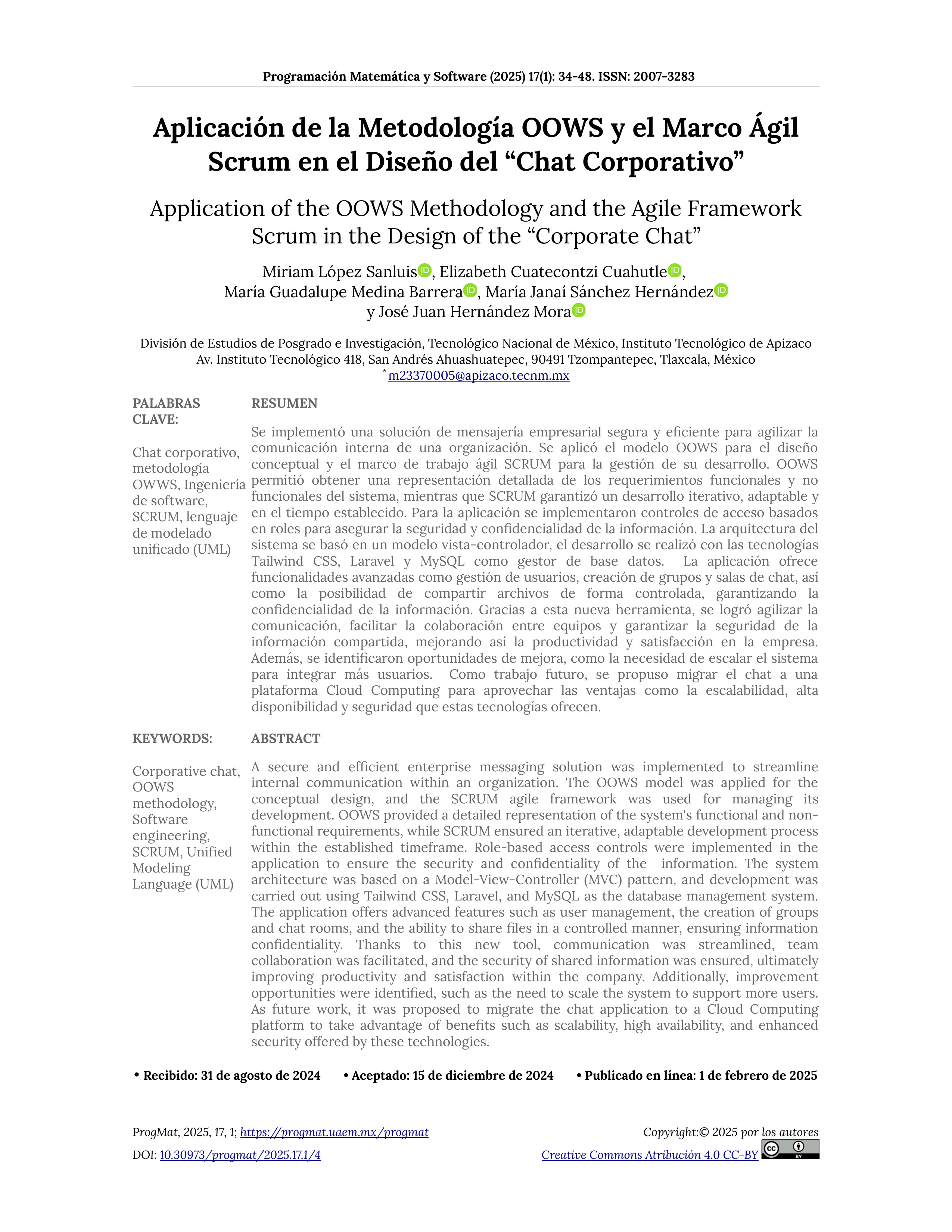Aplicación de la Metodología OOWS y el Marco Ágil Scrum en el Diseño del “Chat Corporativo”
DOI:
https://doi.org/10.30973/progmat/2025.17.1/4Palabras clave:
Chat corporativo, metodología OWWS, Ingeniería de software, SCRUM, lenguaje de modelado unificado (UML)Resumen
Se implementó una solución de mensajería empresarial segura y eficiente para agilizar la comunicación interna de una organización. Se aplicó el modelo OOWS para el diseño conceptual y el marco de trabajo ágil SCRUM para la gestión de su desarrollo. OOWS permitió obtener una representación detallada de los requerimientos funcionales y no funcionales del sistema, mientras que SCRUM garantizó un desarrollo iterativo, adaptable y en el tiempo establecido. Para la aplicación se implementaron controles de acceso basados en roles para asegurar la seguridad y confidencialidad de la información. La arquitectura del sistema se basó en un modelo vista-controlador, el desarrollo se realizó con las tecnologías Tailwind CSS, Laravel y MySQL como gestor de base datos. La aplicación ofrece funcionalidades avanzadas como gestión de usuarios, creación de grupos y salas de chat, así como la posibilidad de compartir archivos de forma controlada, garantizando la confidencialidad de la información. Gracias a esta nueva herramienta, se logró agilizar la comunicación, facilitar la colaboración entre equipos y garantizar la seguridad de la información compartida, mejorando así la productividad y satisfacción en la empresa. Además, se identificaron oportunidades de mejora, como la necesidad de escalar el sistema para integrar más usuarios. Como trabajo futuro, se propuso migrar el chat a una plataforma Cloud Computing para aprovechar las ventajas como la escalabilidad, alta disponibilidad y seguridad que estas tecnologías ofrecen.
Citas
Velarde Paredes G, Pilco Quitiu MI. Análisis comparativo de metodologías para el desarrollo de la aplicación web del control de las prácticas pre-profesionales de la EIS de la ESPOCH [tesis de grado]. Riobamba (Ecuador): Escuela Superior Politécnica de Chimborazo, Facultad de Informática y Electrónica, Escuela de Ingeniería en Sistemas; 2014 [consultado 30 de julio de 2024]. Disponible en: http://dspace.espoch.edu.ec/handle/123456789/3576
Valverde F, Panach JI, Aquino N, Pastor Ó. Hacia un Modelo de Interacción Abstracto para la Definición de Interfaces Multiplataforma. En: Macías Iglesias JA, Granollers Saltiveri T, Latorre Andrés PM, coordinadores. Actas del VIII Congreso Internacional de Interacción Persona Ordenador (INTERACCIÓN 2007). Madrid: Thomson; 2007. p. 251-260. [consultado 30 de julio de 2024]. Disponible en: https://producciocientifica.uv.es/documentos/5eb09d90299952764112d126
Vinay Kumar T, Yathish C, VikeshReddy, Shamanth D, LaxmiRananavare. Internet Chat Application. International Journal of Advanced Research in Computer Science [Internet]. 2021 [consultado 30 de julio de 2024];12(2):98-100. Disponible en: https://www.ijarcs.info/index.php/Ijarcs/article/view/6731/5427
Cherckesova L, Safaryan O, Reshetnikova I, Nikishina T, Korochentsev D. Corporate chat under DLP–system controlling. E3S Web of Conferences [Internet]. 2021 Jun 22;273:08048. XIV International Scientific and Practical Conference “State and Prospects for the Development of Agribusiness - INTERAGROMASH 2021”. https://doi.org/10.1051/e3sconf/202127308048
Kumar M, Thakur V, Gurjar D. Multi-User Web Chat Application using Node.js and Socket.io. International Journal of Advanced Research in Science, Communication and Technology (IJARSCT) [Internet]. 2022 [consultado 30 de julio de 2024];2(4):386-394. Disponible en: https://ijarsct.co.in/Paper3940.pdf
Dong L, Hua Z, Huang L, Ji T, Jiang F, Tan G, Zhang J. The impacts of live chat on service–product purchase: Evidence from a large online outsourcing platform. Information & Management. 2024;61(3):103931. https://doi.org/10.1016/j.im.2024.103931.
Daniel G, Cabot J. Applying model-driven engineering to the domain of chatbots: The Xatkit experience. Science of Computer Programming. 2024 Jan;232:103032. https://doi.org/10.1016/j.scico.2023.103032
Muñoz Sánchez Y, Alonso-Lavernia MA, Castillo-Pérez I, Martínez-Lazcano V, Gálvez-González F. Desarrollo de un Sitio Web con metodologías de Diseño Hipermedial y de Diseño Dinámico. Ingenio y Conciencia Boletín Científico De La Escuela Superior Ciudad Sahagún. 2020;7(13):36-41. https://doi.org/10.29057/escs.v7i13.5263
Castillo Montes M, Vargas Enríquez J, García Mundo L. Modelado Conceptual de una Aplicación Web usando la Metodología OOWS: Caso Práctico. TecnoINTELECTO. 2018;15(12):19-28 [Internet]. [consultado 29 de julio de 2024]. Disponible en: https://es.scribd.com/document/597541404/2-Modelado-conceptual-de-una-aplicacio-n-Web-usando-la-metodolgi-a-OOWS
Schwaber K, Sutherland J. Guía de Scrum: La Guía Definitiva de Scrum: Las Reglas del Juego [Internet]. 2020 [consultado 29 de julio de 2024]. Disponible en: https://scrumguides.org/docs/scrumguide/v2020/2020-Scrum-Guide-Spanish-Latin-South-American.pdf

Publicado
Cómo citar
Número
Sección
Licencia
Derechos de autor 2025 Miriam López Sanluis, Elizabeth Cuatecontzi Cuahutle, María Guadalupe Medina Barrera, María Janaí Sánchez Hernández, José Juan Hernández Mora

Esta obra está bajo una licencia internacional Creative Commons Atribución 4.0.
Usted es libre de:
 |
Compartir — compartir y redistribuir el material publicado en cualquier medio o formato. |
 |
Adaptar — combinar, transformar y construir sobre el material para cualquier propósito, incluso comercialmente. |
Bajo las siguientes condiciones:
 |
Atribución — Debe otorgar el crédito correspondiente, proporcionar un enlace a la licencia e indicar si se realizaron cambios. Puede hacerlo de cualquier manera razonable, pero de ninguna manera que sugiera que el licenciador lo respalda a usted o a su uso. |
| Sin restricciones adicionales: no puede aplicar términos legales o medidas tecnológicas que restrinjan legalmente a otros a hacer cualquier cosa que permita la licencia. |









